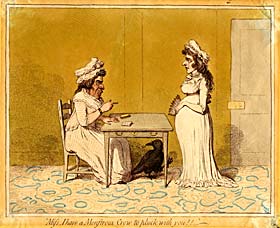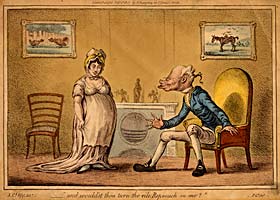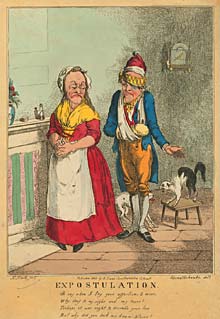English Caricature: Love & Doomed Relationships
No subject was off-limits for satirists, and there was no more tantalizing material than relationships between men and women. In this series of caricatures, the artists used a medical condition or medical injury to describe a doomed relationship. Domestic violence, questionable pregnancies, jealousy, and even physical pain were all by-products of unhealthy relationships.
Caricaturists lampooned topics that today might be considered in poor taste. Henry Heath in his etching entitled, “Expostulation,” demonstrates how marital discord could be a catalyst for more brutal moments of domestic abuse. The two hissing cats symbolically portray the man and woman’s bitter relationship. However, Heath’s humor lies in role reversal. In this case, it is the man who suffers bodily injuries at the hands of his dour wife. His hand and arm are bandaged and wrapped in a sling. His eye appears bruised and black and is also encased in a bandage. He pleads his case to the woman who rejects him by turning her back to him. The caption reads:
Oh say when I try your affections to move,
Why deaf to my sighs and my tears?
Perhaps it was right to disemble your love.
But why did you kick me down Stairs?
In this elaborate etching, George Cruikshank delves into the life of a man overwrought with jealousy. The protagonist sits at a table strewn with documents, and his head rests on his hand. A letter from an anonymous correspondent lies open in front of him. The contents of the letter disturb him and leave him pondering its information. He is so deep in thought that he is oblivious to the whistling kettle on the stove. Two devilish imps are perched on the main character’s shoulders. Both are encouraging the protagonist to notice what is going on around him. One little demon hands him a pair of glasses as if to say, “Open your eyes!” The other imp sits on his shoulder and points to a love scene below. In this case a dandified soldier reaches up to his lover as she climbs down a rope ladder, perhaps symbolizing an escape from an upstairs window. In another scene a soldier and a woman secretly cuddle underneath a chair. It appears that the letter has informed the distraught character that the woman in his life is carrying on an illicit love affair.
The man’s jealous thoughts lead him to contemplate the end of his life. Cruikshank draws two scenes of death, both featuring men dressed similarly to the protagonist. In the scene on the mantle, a soldier shoots a figure at close range. In the other setting, a man commits suicide by hanging himself. He has kicked aside the footstool as a devilish imp, sprawled on the table, holds the rope. The viewer is left to wonder whether the revolver (comically drawn with arms, legs, and a top hat) resting near the right hand of the protagonist will be used in a fit of jealousy.

Miss I have a Monstrous Crow to pluck with you!! James Gillray, published by H. Humphrey, No. 57 New Bond Street, November 1, 1794.
In this 1794 hand-colored etching, a man dressed as a woman points his finger and utters, “Miss, I have a Monstrous Crow to pluck with you!!” The “Miss” is addressed to a visibly pregnant woman. The words “monstrous crow” is a euphemism (made popular in a Mother Goose nursery rhyme) for battle. The large black crow under the table squawks “Oh! Too Bad!” Though superficially a commentary on a personal relationship, the caricature probably had deeper political connotations.

__and would’st thou turn the vile Reproach on me? James Gillray, published by H. Humphrey, 27 St. James’s Street, London, February 2, 1807.
This caricature addresses failed love. James Gillray draws a beautiful and very pregnant woman standing before a grotesquely unattractive man. The man’s face emulates that of the emaciated stallion in the painting behind him, and the folds on his jacket bear a resemblance to the rib cage of the horse. Behind the woman is a picture of a hen and a cock fighting. On the mantle is a statue of Venus, but the cupids on either side have turned their backs to her.
The relationship between King George IV and his estranged wife, Queen Caroline, provided a wealth of material for the satirist.23 In this caricature attributed to Theodore Lane, the artist describes the King’s “moments of pain” upon the return of his exiled wife for his coronation in 1820. The artist draws a distressed King George IV languishing in a room decorated with “Asian exoticism,” an allusion to the King’s opulently decorated Royal Pavilion. Historians note that the obese King was addicted to laudanum. The artist suggests this addiction by including a box of pills and a bottle of medicine on the table next to the king.
King George IV and Queen Caroline despised each other from the moment they met, and only married for convenience. (The then Prince George married his first cousin, formerly Caroline of Brunswick, as a means to get Parliament to pay off his sizeable debt.) After consummating their marriage and producing one heir, they lived apart for the remainder of their lives. When King George IV ascended to the throne in 1820, Caroline returned to England to assume her duties as queen. The King desperately wanted to divorce his wife and proceeded to try to pass a “Bill of Pains and Penalties” which would deny Caroline her title, prerogatives, rights, privileges, and exemptions as queen. In this caricature, the artist draws a large scroll filled with a list of addresses to the Queen, as two of the King’s courtiers, Henry Addington and Benjamin Bloomfield, attend to his needs. The Bill was defeated in the House of Lords by a vote of 123 to 95. Fortunately for the King, his scorned queen died in 1821, two weeks after he refused her entry to his coronation.


